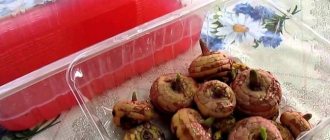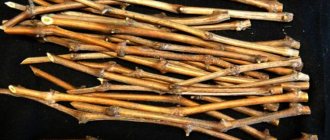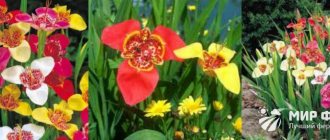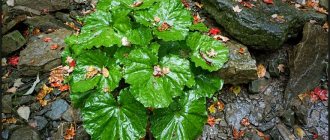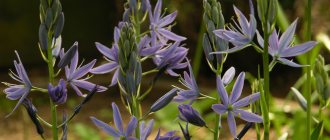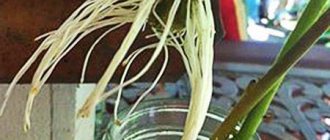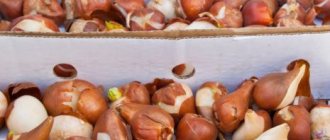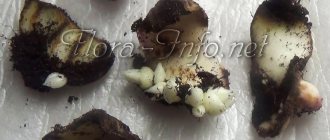Description and features
Tigridia is one of the varieties of perennial herbaceous crops that originated from South America. The height of the flower reaches 30-70 centimeters. The rhizome is a bulbous formation. On top it is covered with dry films of a brown tint.
The leaves have a belt-like shape and a corrugated texture. They form a fan and emerge directly from the rosette. There is a straight stem in the central part .
Flowering of the plant begins in July and continues until autumn frosts. Each bulb produces 6 peduncles. They have 2-3 buds. The corolla includes 6 petals, 3 of which are larger.
After flowering ends, fruits appear on the plant in the form of boxes. Each of them contains several brown seeds.
How to plant in open ground
To grow a strong and viable plant, it is necessary to adhere to the timing and technology of planting.
Deadlines
It is recommended to plant tigridia in the soil in late spring. It is best to do this in May. In the south, planting work can be carried out at the beginning of the month, in moderate latitudes - in the middle. It is not worth planting the plant in the fall.
Preparation of planting material
The simplest method of propagating a flower is considered to be bulbous. To do this, it is recommended to plant already sprouted bulbs in the ground. You can also grow the plant from seeds. To do this, it is enough to sow them in spring in boxes or pots. When the frosts have passed, the seedlings are transferred to the ground.
Planting scheme
First, you need to make 8-12 centimeter depressions in the area and water them. Between the holes you should maintain a distance of 15-20 centimeters. This will provide the sprouts with sufficient space and make it easier to care for.
Preparing tigridia for wintering
Tigridias are heat-loving perennials. Therefore, in most climate zones they are not able to winter in open ground. To protect valuable planting material from freezing, gardeners practice digging up bulbs in the fall. And while growing tigridia can be done even by novice gardeners, the process of winter storage can cause difficulties.
The main condition for successful storage is complete ripening of the bulbs. To do this, it is necessary to ensure timely planting of tigridia and regularly remove wilted buds. If frost is approaching and the leaves are still green, you should carefully dig up the plant and move it, along with a large lump of earth, to a well-lit, cool room. You can clear the soil from the bulb only after the above-ground part of the plant has completely withered.
Before storing, planting material must be thoroughly dried. But you shouldn’t separate the bulbs. It is better to postpone this procedure until spring. Maintaining temperature and humidity conditions is equally important. Planting material is stored immersed in containers with dry peat or sand. The air temperature should vary from 3 to 10 degrees.
Growing and care
Caring for the crop is quite simple. It is enough to water it and apply fertilizers in a timely manner. Mulching the soil is of no small importance.
Watering
The plant needs sufficient watering. Regular soil irrigation is not enough. When growing tigridia, it is important that the soil is well saturated. The frequency of watering is chosen taking into account the frequency of precipitation. In dry summers, this procedure is carried out every day, and the upper part of the flower is additionally irrigated.
Loosening and weeding
Tigridia does not need loosening. It is enough to cover the soil with peat or humus. In this case, you need to systematically weed the beds. This will help prevent the spread of weeds.
Top dressing
After planting the plant, you need to add nitrogen fertilizer to the soil. 30-40 grams of fertilizer are used per 1 square meter. When tigridia begins to bloom, use nitrophoska in the same volume.
Some gardeners fertilize the plant at intervals of 2-3 weeks, using a complex preparation. It is applied at the root during watering.
Mulching
To ensure full development of tigridia, the soil surface should be covered with peat or humus. Under such a layer the soil will remain loose for a long time. Mulching helps prevent soil compaction.
Removing faded flowers
After flowering ends, faded buds must be removed. Thanks to timely pruning, it is possible to preserve the decorative properties of the crop and ensure the appearance of new flowers.
See also
Planting and caring for tuberose in open ground, rules for growing and storingRead
Installation of supports
Weak plants need additional support. It is recommended to tie them to supports. Otherwise, the first gusts of wind will lead to breakage of flower stalks.
Transfer
For earlier flowering, the bulbs should be grown at home. At the beginning of spring, they are planted in a pot and provided with moderate watering. As germination progresses, the soil needs to be moistened more and more. When arrows appear, the plant should be moved to a warm windowsill.
It is recommended to replant the flower in open ground in early June. To do this, you need to make a hole 50-60 centimeters deep. It is worth considering that after transplantation the crop requires abundant watering.
Caring for tigridia in the garden
Growing tigridia in your garden is quite simple. She needs to ensure timely watering, weeding, fertilizing and loosening the soil surface between the bushes. Experienced gardeners advise covering the surface of the area with a layer of mulch; this will not only preserve the structure of the soil, but will also reduce the number of watering, weeding and loosening. It will also be necessary to promptly remove flowers that have begun to fade, and, if necessary, tie the bushes to pegs or twigs.
How to water and feed
When grown in the garden, this plant requires systematic watering. During prolonged drought, the bushes should be watered every day, and such a volume of water should be used so that the soil can get wet to the depth of the corms. Also, during prolonged drought, the aboveground part of the bushes will need to be moistened with lukewarm water from a spray bottle in the evening.
If, in preparation for planting, all the necessary fertilizers were added to the soil, then you can forget about feeding tigridia until the end of the season. If the soil is poor or depleted, then the bushes will need to be fed only a couple of times per season, and for this they use a solution of complex fertilizer (3 grams per 1 liter of water). Fertilizing should be done 4 weeks after foliage appears and during budding.
Transfer
In order for the plants to bloom earlier, at the beginning of the spring the bulbs need to be grown indoors. They should be planted in the last days of March in a pot with a light soil mixture. 3 or 4 corms are planted in 1 pot at once, and they need to be buried into the substrate no less than 30 mm. In the first weeks, the bulbs will need to be provided with moderate watering. After the corms begin to germinate, the amount of watering must be increased; it should be taken into account that the substrate should be wet to the depth at which the roots of the corms are located. It is best to choose pots with wide holes for drainage for planting corms, and the plate stand should be quite high so that tigridia can be bottom watered. With this type of watering, the risk of developing fungal diseases is comparatively lower. After the arrows appear, the containers with tubers must be transferred to a well-lit, warm windowsill. Remember that drafts are contraindicated for these plants. These corms are planted in open soil in the first days of June.
The depth of the planting pit for the transplanted plant should be from 0.5 to 0.6 m. At the bottom of the pit, a drainage layer should be made of horse manure or broken brick, and its thickness should be from 0.2 to 0.25 m. On top It should be laid with a layer of loose soil of the same thickness as the previous one. Then the sprouted corm must be placed on it, after which the hole is covered with nutritious soil. Transplanted plants need abundant watering.
Reproduction of Tigridia
If the bushes begin to bloom from mid to late July, then the seeds will be able to ripen before frost. Seeds are collected before frost begins. They are sown in winter, and pre-sowing preparation of the seeds is not required. The containers are placed in a well-lit, warm (20 to 25 degrees) place. When picking seedlings, you need to be very careful to avoid damaging their roots. After the seedlings develop a pair of true leaf blades, they should be picked into individual pots, and they are taken together with a lump of earth. From the moment of sowing to the beginning of flowering, approximately 6–7 months pass.
Vegetative methods can also be used to propagate this crop. Over the course of 1 season, one adult corm produces about five replacement children. They should be separated from the parent bulb before planting, and the places of breaks and cuts should be sprinkled with coal powder, after which the children can be planted in the soil.
Diseases and pests
Quite often, gardeners are unable to preserve tigridia planting material until spring, because most of it rots. As a rule, rot appears on those bulbs that have not ripened well. That is why it is extremely important, before preparing the corms, to make sure that they are well ripened. Also, for prevention purposes, you should be sure to poison the corms before storing them in any fungicidal solution, for example: Maxim, Benlate or Fundazol.
A plant grown in open ground may be affected by scab or rust. To prevent this, it is recommended to spray the foliage with herbal infusions or fungicide solutions.
If the plant is affected by mosaic, then it is no longer possible to cure it, since viral diseases are currently considered incurable. In this regard, it is extremely important to provide the plant with proper care and conditions suitable for growth so that it is strong and less painful.
Mole crickets, slugs, cabbage cutworms and thrips can harm tigridia. To exterminate thrips, as well as cutworms, along with their caterpillars, the foliage of the bushes must be sprayed with a solution of any insecticide. To make the work easier, slugs are collected by hand; pieces of slate or boards are laid out around the area, under which most of the gastropods crawl during the hottest time of day. Remove them from under the baits and destroy them. And it is necessary to pour a solution of soap into the discovered mole cricket passages. If the mole cricket tries to escape by getting out, it should be caught and destroyed.
Reproduction
Tigridia can be propagated using seeds or bulbs. Each method has certain features.
Collection and storage of seeds
Planting material can be bought at a special store or prepared independently. To do this, you need to remove the seeds from the seed pod. At the beginning of spring they are planted in a special container. After 2 weeks, sprouts will appear. At the beginning of summer, tigridia is transplanted into the soil.
Vegetative method
The more common propagation method is bulbous. This is a fairly simple manipulation. To carry it out in the spring, the bulbs are divided into several fragments and planted in open soil.
Sowing seeds
Tigridia seeds have excellent germination rates. Therefore, it is not difficult to grow it this way. You just need to correctly calculate the sowing time. If planted late in spring, the bulbs will not have time to ripen before the cold weather. Therefore, the seedling method of cultivation is usually practiced. If you sow in winter, then before the onset of autumn the bulbs will get stronger and will be ready to produce beautiful, healthy flower stalks next season.
For soil, it is best to use a soil mixture with the addition of sand and a small amount of peat. The seeds should not be buried too deep. It is enough to cover them with a layer of soil of 2-3 mm. The distance between adjacent seeds should be no less than 5 cm. It is better to place each plant individually. This will help avoid additional transplantation in the future.
With regular moistening, the first shoots will appear above the ground in 2-3 weeks. After a month, if necessary, they are seated in separate containers. Seedlings can be transferred to open ground at the end of spring, when above-zero temperatures have stabilized.
How to dig and store in winter
Preparing the crop for wintering is of great importance. The plant can bloom before frost, but in this case the bulbs do not have time to accumulate nutrients for the next season. Therefore, a couple of weeks before the temperature drops, the flower stalks should be cut off. When the leaves wither, the bulbs need to be dug up.
It is worth removing only part of the soil to avoid damage to the daughter shoots. Within 1 month after digging, the bulbs are dried at room temperature. After 15-18 days, they get rid of the remaining soil, completely cut off the roots and remaining greenery.
Dried onions should be stored in a cool, dry place. It is recommended to do this in a container with sand. In conditions of high humidity, they should be placed in nets and hung.
Tigridia in winter
Tigridia storage
Due to its heat-loving nature, wintering tigridia in open ground is impossible in most climatic zones: in the fall, plant bulbs are dug up and stored until spring at a low but above-zero temperature. And it is precisely with the extraction from the ground and storage of corms that the difficulties of growing tigridia are associated. The main condition for the normal storage of planting material for this crop is the complete ripening of the bulbs, so it is important to know when to dig up tigridia in the fall. The bulbs can be stored only after the above-ground part of the plant has withered, but if frost is approaching and the leaves on the tigridia are still green, you should dig up the corms with a large earthen lump, bring them into a bright, cool room, wait until the dug-out plant turns yellow and the leaves will wither, and only after this will it be possible to prepare the corms for storage.
Before storing in storage, the planting material must be cleaned, washed, pickled in a solution of the drug Maxim, dried well, but there is no need to separate the children from the mother corms - postpone this procedure until spring. How to store tigridia before planting? The bulbs are immersed in dry peat or sand and kept in a room with normal humidity at a temperature of 3 to 10 ºC. You can put the planting material in paper bags and place it in the vegetable drawer of the refrigerator. During the winter, it is necessary to periodically check the condition of the bulbs in order to detect damage or rotting in time.
Diseases and pests
The plant quite often encounters various diseases and harmful insects. To avoid problems, it is worth treating the flower on time.
Rot
This disease manifests itself in the form of focal spotting on the leaves and stems of the crop. A viscous mush accumulates in each spot. It may have a brown, white or black tint. Bordeaux mixture will help cope with the problem. You can also use Cuproxat.
Rust
The disease is accompanied by the appearance of round formations on the flower. They can come in different sizes, but always include a bright red colored powder. When cracked, it spills out. To eliminate the disease, you need to use Polygard, Flutrivit or similar drugs.
Scab
The disease is characterized by foci of infection on the surface of the culture. This causes the top layers of the leaves to peel off. Spots, ulcers, and warts appear on them. To prevent the disease, it is worth treating 2-4 times during the season with such agents as Fitosporin-M, Profit Gold or similar drugs.
Thrips
Small black dots on the plant help identify the pest. With severe damage, parasites provoke the appearance of dry ulcers. They also cause foliage to curl and die. A characteristic feature of infection is dry netting on the leaves. Abamectin and Fitoverm help to cope with thrips.
Slugs
They eat young leaves and stems, which provokes general oppression of the plant. To identify slugs, you should pay attention to the white mark on the plant and soil. Glanzit, Mesurol and similar drugs help control pests.
Cabbage scoops
The caterpillars of this insect eat buds, foliage, and seed pods. The pest overwinters in the soil. Therefore, before frost, you should dig up the soil. As a result, the cutworm pupae will end up on the surface of the ground, which will lead to their death.
Medvedki
These pests attack the bulbs and root system of the plant, which leads to its wilting. Parasites can be detected by small bumps and holes in the ground. Before planting, the bulbs should definitely be treated with Confidor, Aktara or similar means.
See also
The best varieties and varieties of cinquefoil, description and featuresRead
Tigridia seedlings
It is worth noting that when planted directly into the soil in late spring, the new bulbs do not develop particularly well, so even if you live in warm regions, it may be advisable to plant in pots in advance.
In more northern regions, located at the level of St. Petersburg, it is better to plant early (in early spring) in pots and grow them in greenhouses before the beginning of summer.
As a rule, tigridia bulbs are placed in pots in a mixture of peat, sand and turf soil, 3 pieces each. They are watered a little, and when the sprouts hatch, the watering is increased. Before transplanting to a flowerbed, they are grown under normal indoor conditions. If such growing is not carried out, the shoots may begin to stretch upward unnecessarily and will have to be tied to supports.
At the beginning of summer, transplantation is carried out in open soil, often done together with a pot. It is advisable that before the procedure, put 30 cm of horse manure mixed with foliage in the holes, and the same amount of soil on top, and then lower the pot with the plant.
Popular varieties
Tigridia has about 50 species. They differ in height, bud color, and growing conditions.
Alba
This perennial plant is characterized by branching stems. They can reach 60-70 centimeters in height. The leaves have an elongated shape and a light green tint. They are covered with longitudinal folds. The plant usually has 5 flower stalks. Each of them contains 4-5 buds. They bloom one by one. The flowers are characteristically cup-shaped. The diameter is 10-15 centimeters.
Aurea
This ornamental plant has fairly strong and straight stems. They are 45-55 centimeters in height. The culture does not need to be tied up. The inflorescences are cup-shaped. The petals have a rich yellow tint and a scarlet center. The diameter is 10-14 centimeters. The leaves are characterized by a light green tint and an elongated shape. Flowering begins in July.
Carminea
The flower has a fairly strong stem 65 centimeters high. The leaves have a green tint and contain longitudinal veins. Each plant has 3-4 peduncles, which form 4-5 inflorescences. The flowers are cup-shaped. The petals are characterized by a rich orange hue. The middle is covered with yellow spots. The diameter of the flowers is 13-14 centimeters. Flowering continues throughout July and August.
Lilacea
This crop is characterized by straight stems 50-60 centimeters high. The leaves are elongated and covered with veins. They are characterized by a light green hue and a pointed shape. The inflorescences have a bright hue. The petals are soft pink, and in the middle you can see carmine spots. The shape of the flowers resembles a bowl. Their diameter is more than 11 centimeters.
Rosalind
The height of the plant reaches 40-50 centimeters. The leaves are oblong in shape and covered with veins. The plant has up to 5 peduncles, which contain 3-5 inflorescences. The petals have a soft pink tint. They reach 12-14 centimeters in diameter. The flower is shaped like a bowl. The plant blooms from July to August.
Canariensis
The plant has dim inflorescences of pastel colors. At the same time, the bud has a rich red tint. The size of the inflorescences is 10-15 centimeters.
Speciosa
The flower is characterized by straight stems that reach 45 centimeters in height. Each plant has 5 flower stalks with 4-5 inflorescences. The petals have a rich red tint. In the middle, red spots can be seen on a yellow background. The flowers resemble a bowl in shape. They reach 15 centimeters in diameter. The plant begins to bloom in July.
Ferrari mixed
The Tigridia Ferraria mixed variety mixture is very popular. The height of the bush reaches 60 centimeters. The leaves are sword-shaped. The flowers are 15 centimeters. The outer petals are uniform in color. It can be yellow, red, white. There are lilac-pink and orange flowers. There are spots on the inner petals.
Tigridia species
In domestic gardens, tigridia is represented by a modest assortment of varieties. The most popular:
- Alba;
- Canariensis;
- Auer;
- Lilacea.
Tigridia Alba is a variety with large white flowers decorated with a variegated red center. The diameter of the opened bud varies within 15 cm.
Tigridia Canariensis is a plant with dim inflorescences of pastel shades. The center of the bud is bright red. The size of the inflorescence varies from 10 to 15 cm.
Tigridia Auera has bright yellow petals framing a variegated core. The buds are large, up to 15 cm.
Tigridia Lilacea is a variety with pink petals and a traditional patterned bud core. The size of the inflorescences exceeds 10 cm.
Use in landscape design
Tigridia is often used in landscape design to create group plantings. When planting different varieties of plants in one place, it is possible to obtain a variegated flower bed. At the same time, it is important to remember a sense of proportion. You should not combine the plant with others with variegated flowers.
Bright flowers look very beautiful on a green background. It is created by low plants and lawn. Green coniferous crops and shrubs are well suited. The advantage of tigridia is the ability to grow in tubs or pots.
Tigridia is a spectacular plant that can become a real decoration for a flowerbed or garden. To get a strong and viable flower, it needs to be properly cared for. To do this, it is worth considering the basic recommendations of experts.
